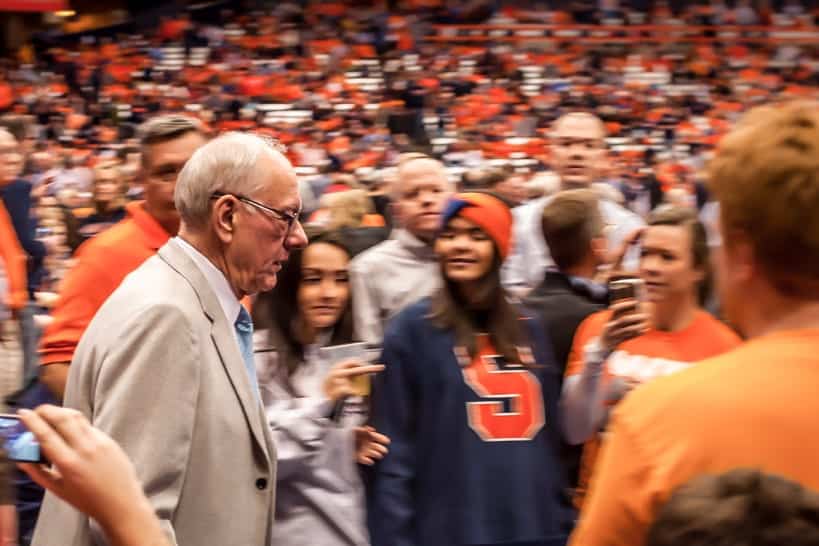One high profile fatal accident shows how negligence rules can affect compensation.

By Seth R. Lindberg, attorney Burnett & Williams P.C., Loudoun, Fairfax, and Northern Virginia
Jim Boeheim, the longtime, second-winningest active coach in the NCAA, struck and killed a pedestrian on Wednesday, February 20, 2019, in Syracuse, New York. After defeating the #18 Louisville Cardinals by 20 points in the Carrier Dome, Boeheim departed the Syracuse University campus for Joey’s, a nearby Italian restaurant. Boeheim left the restaurant after 11 p.m. and headed home in his GMC Acadia.
Earlier that night, freezing rain had fallen. While on I-690, one of the major highways in Syracuse, Boeheim spotted a black Dodge Charger that was perpendicular in the center lane. Apparently, the Charger was involved in a collision moments prior. The Charger was blocking the center lane and most of the left lane. As the Charger was blocking several lanes of travel, at least one vehicle swerved around it. The occupants exited the vehicle, attempting to find safety to avoid being struck by an oncoming car while stopped.
Boeheim then struck, Jorge Jimenez, a passenger of the Charger. Mr. Jimenez was near the side of the roadway. Boeheim immediately pulled over to the side of the road, called 9-1-1, and attempted to warn other drivers of the crash using his cell phone flashlight. Mr. Jimenez was taken to a local hospital where he was pronounced dead. It is unclear whether the freezing rain played any part in causing the accident.
Police investigators then interviewed Boeheim at the scene of the accident and at the local Public Safety building in downtown Syracuse. Boeheim also submitted to an alcohol breathalyzer. Boeheim, a famous teetotaler, registered a 0.00 BAC. Based on the facts of the accident, prosecutors have declined to pursue any criminal charges against Boeheim (or anyone else involved in the accident). Syracuse Police Chief Kenton Buckner described the death of Mr. Jimenez as “a tragic accident”.
Based on the facts as presented in the media articles, if this accident occurred in Virginia, Boeheim would almost certainly be found not liable in causing Mr. Jimenez’s death.
Virginia is only one of five jurisdictions that still recognizes contributory negligence. This means that if the plaintiff is even one percent at fault in causing the accident, he is barred from any recovery. A Virginia jury would most likely view Mr. Jimenez’s standing in the highway at night as a contributing factor in his injury and death. Those facts would likely preclude recovery in Virginia.
However, the accident occurred in New York. New York is a pure comparative negligence state. Comparative negligence permits the plaintiff to recover against the defendant even if he is at fault. New York law permits an individual to sue, and recover, against a defendant even if he is mostly at fault for causing that accident. However, under New York law, that recovery is reduced by the plaintiff’s fault. So, if the jury finds that the plaintiff is 99% at fault in causing the accident, the plaintiff can still recover 1% of damages from the defendant.
In the Jimenez case, police found no evidence of any wrongdoing against Boeheim and have declined to pursue charges. Media reports have all suggested that Boeheim did nothing wrong in causing Mr. Jimenez’s death. As the facts stand now, it is unlikely that Mr. Jimenez’s family would receive a sizeable recovery. However, Boeheim’s insurance company may ultimately extend a small settlement offer to Mr. Jimenez’s estate to preclude a future lawsuit against Boeheim.
If you are ever involved in a car crash on a highway, do your best to move your vehicle to the shoulder, if it is drivable. The evidence will be preserved if the damaged cars are moved several feet to the shoulder. However, if your car is disabled and not drivable then: stay in the car. Modern cars are designed to withstand considerable forces from collisions. Even if your car is struck while disabled, the car provides crash protection in the form of reinforced bodywork, crumple zones, and airbags.